Being a biological oceanographer on a physical oceanographic voyage has highlighted a key distinction between the two disciplines. Physical oceanographers rely on sensing – deploying instrumentation that measures properties of the water: temperature, velocity, oxygen, etc. Those data are sent back to laptops allowing for near instantaneous analysis. The day-to-day work of biological oceanography, on the other hand, may be a science best described by filtering – a task that is intertwined with most measurements in our field. We collect water and remove the particles or organisms we want to study. The finest filter might have holes that let only the tiniest particles through, while the largest filter could be something like a large net, where even fish can slip through its mesh.
News
NASA's New Mission Explores Earth's Oceans
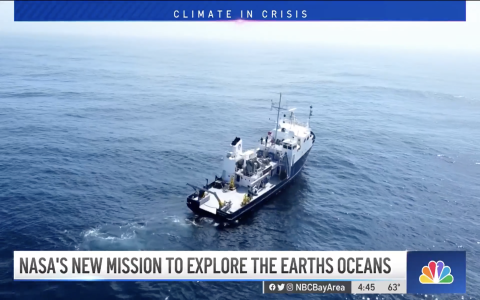
NASA scientists are flying off the California coast to see how the weather of the ocean interacts with the Earth’s climate and the journey started at NASA’s Ames Research Center in Mountain View. Vianey Arana reports.
A look at NASA’s new mission to explore the Earth’s oceans

Scientists at NASA are on a mission to study the surface of the Earth's oceans to observe how eddies, whirlpools and currents interact with the atmosphere and shape the Earth’s climate. NBC’s Jacob Soboroff reports for TODAY.
NASA takes research to the sky and sea to track impacts of climate change
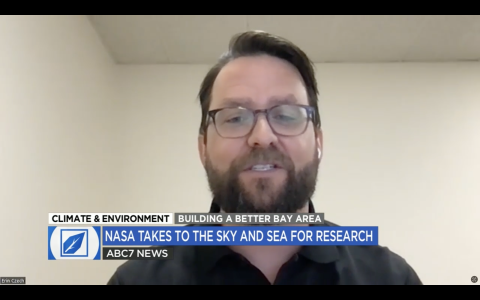
NASA has been tracking the impacts of climate in a place you might not expect the agency to do research. The work is being done in and over the ocean.
"When you think NASA you think space, but we do look at the Earth a lot," said Erin Czech, project manager for NASA's S-MODE or Sub-Mesoscale Ocean Dynamics Experiment, "We have a lot of missions, across the globe, trying to understand our Earth better, S-MODE is one of them."
On the Edge: NASA’s Last S-MODE Mission Studies the Ocean’s Surface
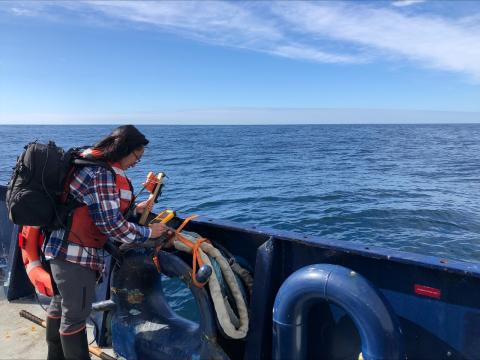
NASA has taken to the seas and skies to study the unique environment at the ocean’s surface, where marine ecosystems intersect with our planet's complex atmosphere. On April 7, 2023, scientists participating in the Sub-Mesoscale Ocean Dynamics Experiment (S-MODE) embarked on the RV Sally Ride from San Diego on the last of three field expeditions to understand the ocean’s role in the Earth’s changing climate. They will be at sea for about a month until returning to San Diego on May 4, and they will operate for most of that period in tandem with an accompanying airborne campaign.
Dr. Brenna Biggs Presents “Wave” Hello to NASA S-MODE: A Study of Sub-Mesoscale Ocean Processes

Dr. Brenna Biggs hosted a panel of S-MODE scientists at an Earth Day event at the Chabot Space and Science Center for K-12 students on April 22, 2023.
NASA's S-MODE Mission: "Sea-ing" through Rainbow-Colored Glasses

If you asked a random person about the color of the ocean, they would probably tell you that it’s some shade of blue or green. But perhaps that shade of blue looks slightly different to you than it does to the random stranger you’re bothering about the color of the ocean. The way you see color depends on many things: the way an object interacts with incoming light, the color of that incoming light, and even the way your eyes perceive that light. The stranger likely has cone cells in their eyes that perceive light differently than yours. When light from the sun enters the ocean, it is scattered or absorbed by phytoplankton (microscopic organisms in the ocean that produce oxygen, take up carbon dioxide, and serve as the base of the marine food web), organic matter, minerals, and other constituents in the water, as well as the water itself.
A Month at Sea: Scientists Prepare to Set Sail for NASA's S-MODE Mission

In early October, the research vessel Bold Horizon set sail from Newport, Oregon, and joined a small fleet of planes, drones, and other high-tech craft chasing the ocean’s shapeshifting physics. NASA’s Sub-Mesoscale Ocean Dynamics Experiment (S-MODE) looks at whirlpools, currents, and other dynamics at the air-sea boundary. The goal is to understand how these dynamics drive the give-and-take of nutrients and energy between the ocean and atmosphere and, ultimately, help shape Earth’s climate.
Following the Ocean Fronts
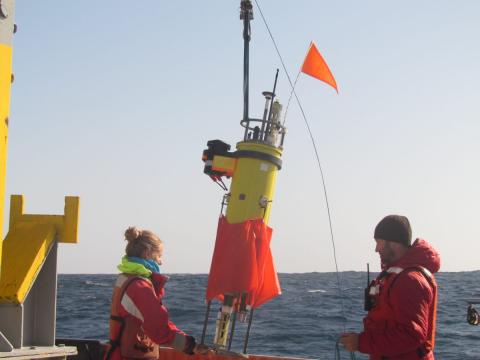
Being part of the NASA S-MODE oceanographic mission was a great experience for me. It was only my second oceanographic mission and my first one on a US research vessel. I learned a lot about how to use the different instruments, interpret their data and about the complexity of the ocean.
This mission is designed to study submesoscale fronts – which correspond to abrupt changes of water temperature or salinity over scales of about 6 miles or 10 kilometers in the ocean. They act in a similar way as we have fronts in the atmosphere that bring us cold or warm weather, rain or dry air masses. S-MODE is making the first observations that show such fronts do play a role in stabilizing our climate by acting as a connector between the deep ocean and the atmosphere and controlling the exchanges of quantities such as heat or carbon.
Life at Sea: Books of the Bold Horizon

ʻAʻohe o kahi nana o luna o ka pali; iho mai a lalo nei; ʻike ke au nui ke au iki, hea lo a he alo. The top of the cliff isn’t the place to look at us; come down here and learn of the big and little currents, face to face (Pukui, 1983, 24).
I brought Sweat and Salt Water: Selected Works by Dr. Teresia Kieuea Teaiwa onboard the R/V Bold Horizon. The book was the last addition to my bag before heading to the airport. I’m not sure why I threw the book in my bag; but I was even more puzzled when I realized late into the cruise, I read Chapter 5: Lo(o)sing the Edge every time I opened the book. Maybe it was the relevance of Dr. Teaiwa’s inclusion of the ʻōlelo noʻeau (Hawaiian proverb) to S-MODE or maybe the navigation of her professional and personal life resonated with my experience navigating aquatic remote sensing as a kānaka maoli (Native Hawaiian) woman. Still in question as the vessel began its final transit to San Diego, I went on a quest to learn about the books brought aboard.
Surface Waves from the Bold Horizon's Deck During NASA's S-MODE Experiments

Upon leaving the Breton coastlines after my Ph.D., I started a postdoc at the Colorado School of Mines. After one month in the Colorado mountains, I traveled to Newport, Oregon, to board the Bold Horizon for one month of measurements offshore of San-Francisco for the NASA S-MODE (Sub-Mesoscale Ocean Dynamics Experiment) field campaign. This experiment focuses on sub-mesoscale currents (spatial scales smaller than about 30 km, or 18 miles, at these latitudes), and tries to assess how important these structures are for the vertical exchange in the ocean and fluxes between the lower atmosphere and the upper ocean.
Cloudy with a Chance for Whirlpools: Ocean Models Guide NASA’s S-MODE Mission

NASA’s S-MODE mission faces quite the challenge: robustly observe, for the first time, ocean features spanning up to about 6.2 miles (10 kilometers) across. Currently, the oceanographic community routinely observes and studies very large ocean features, primarily through space-based instrumentation. These include strong currents such as the Gulf Stream that runs from Florida along the East Coast of the United States all the way to western Europe. Large vortexes are also observed – these being the cyclones and anticyclones you may have seen on your evening weather forecasts.
Where No Map Leads: Reflections from NASA’s S-MODE Mission
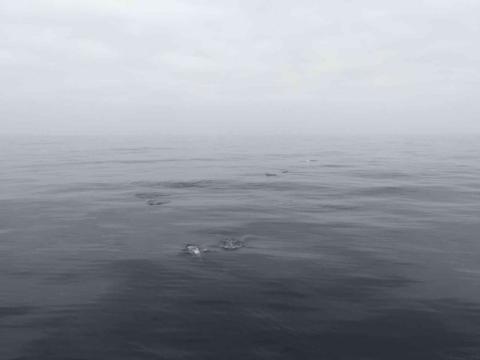
It’s like stumbling through a thick forest and breaking out into a glade. A quiet has settled on this piece of sea as the waves calm. You can’t make a good map to get to this place. In the ocean, these glades are always moving, twisting, being born into life by the collision of great currents, then breaking apart, fracturing and sinking beneath the waves. The cold water brought from below by the coastal winds creates a fog that lies heavy on the sea surface, creating this small, calm spot.
Places like this can be found by things with nowhere else to go. Throw something off the side of a boat and it will likely end up somewhere like here. We’re at a convergence zone that attracts floating debris of all sizes. In particular, it attracts minuscule plankton, along with all the things that eat them and all the things that eat those things and so on and so on. All of it dragged hereby the undulating ocean.
Finding Nature at Sea During NASA’s S-MODE Field Campaign
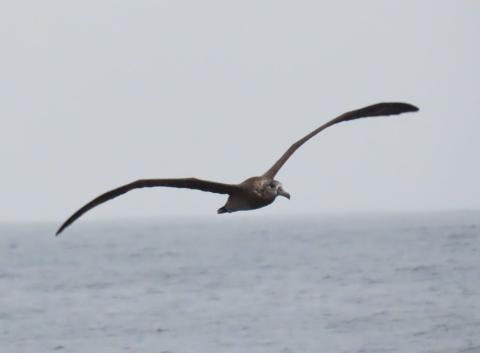
My favorite part of being at sea is the opportunity to see unique parts of the natural world that aren’t accessible from land. My colleagues have done a fantastic job in their blog posts explaining the science that we’ve been conducting during S-MODE, so I want to take this opportunity to describe some of the sights that those of us on the Bold Horizon have been able to enjoy during our field work: birds, mammals, weather, and stars.
NASA's King Air Completes Oceanic Data Collection

Completing more than 80 hours of science flights, NASA Armstrong Flight Research Center’s B-200 King Air supports the Sub-Mesoscale Ocean Dynamics Experiment (S-MODE) in October.
While normally stationed at NASA Armstrong in Edwards, Calif., the aircraft was temporarily stationed at NASA’s Ames Research Center in California’s Silicon Valley to study ocean currents and winds off the coast of San Francisco Bay. The King Air had two instruments onboard; one to measure the ocean winds (DopplerScatt), and the other to observe the ocean surface by camera system (MOSES).
A First Cruise Experience with NASA’s S-MODE Field Campaign
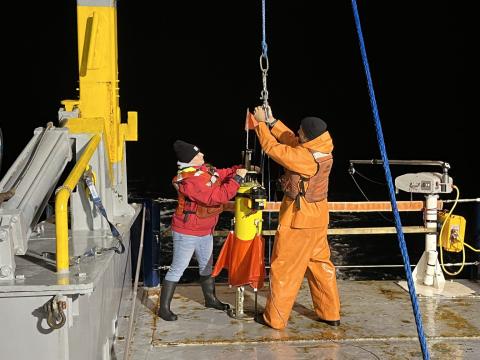
I had been patiently waiting and dreaming about this research cruise for months. Yet a few days before traveling from Connecticut to Oregon for ship mobilization, I couldn’t shake a feeling of denial – like I couldn’t believe I was really going to be out in the Pacific Ocean on a research vessel for an entire month.
I am participating in NASA’s Sub-Mesoscale Ocean Dynamics Experiment (S-MODE) as part of the science party aboard the research vessel Bold Horizon. The focus of this experiment is to sample ocean fronts that are a few miles in size to study their dynamics and effects on vertical transport. The ocean fronts are sampled using aircraft, ship surveying, and autonomous platforms with names such as wave gliders, sea gliders, Saildrones, floats, and drifters. So being aboard the ship is just one piece of this complex research experiment.
Life at Sea: A “First-Timer” Chronicles NASA’s S-MODE Field Campaign

Going to sea for the first time as part of NASA’s S-MODE mission has been an experience like no other. You establish a new normal on the boat and quickly fall into new routines. Perceptions of time even change! I joked with some people on the boat that time is but a label on our samples. Perhaps that’s a bit dramatic, but normal perceptions of time do not apply at sea –especially if you start your day at 2 pm and finish at 2 am.
Student of the Sea: Learning the Ropes Aboard NASA’s S-MODE Mission
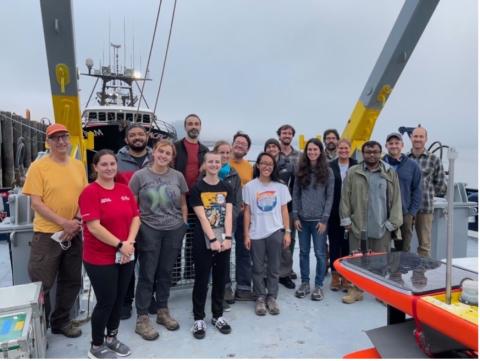
NASA’s S-MODE mission was designed to measure and understand the complex oceanic features classified as “submesoscale,” i.e., features spanning up to 6.2 miles (10 kilometers) across. Such fine filaments and sharp density fronts in the ocean are responsible for fast and unpredictable changes in velocity, temperature, salinity, and even among small organisms called plankton in the surface layer of the ocean. A myriad of autonomous instruments, airborne sensors, and a fully equipped ship are part of the robust methods of measuring submesoscale dynamics in the California Current region.
NASA’s S-MODE Field Campaign Deploys to the Pacific Ocean

When the research vessel Bold Horizon sailed from Newport, Oregon, in early October, it joined a small armada of planes, drones, and other high-tech craft chasing the ocean’s shapeshifting physics. NASA’s Sub-Mesoscale Ocean Dynamics Experiment (S-MODE) is converging on a patch of sea 110 nautical miles off the coast of San Francisco. Over the course of 28 days, the team will deploy a new generation of tools to observe whirlpools, currents, and other dynamics at the air-sea boundary. The goal: to understand how these dynamics drive the give-and-take of nutrients and energy between the ocean and atmosphere and, ultimately, help shape Earth’s climate.
NASA's S-MODE Field Campaign Deploys to Pacific Ocean

NASA’s Sub-Mesoscale Ocean Dynamics Experiment (S-MODE) is converging on a patch of sea 110 nautical miles off the coast of San Francisco. Over the course of 28 days, the team will deploy a new generation of tools to observe whirlpools, currents, and other dynamics at the air-sea boundary. The goal: to understand how these dynamics drive the give-and-take of nutrients and energy between the ocean and atmosphere and, ultimately, help shape Earth’s climate.
Gathering Ocean Intel From Above, On And Under The Waves
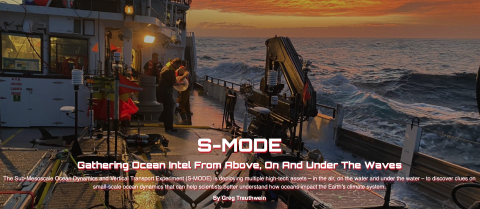
Scientists and researchers across a range of organizations are engaged in a NASA-led campaign 110 nautical miles off of San Francisco to study small-scale ocean processes and dynamics, a study that is aiming to deliver better understanding of how these small processes impact the atmosphere above and below the waves. Perhaps more importantly, the S-MODE project aims to gather and correlate information from below, on and above the waves, a study that could eventually lead to tracking these small-scale processes via satellite to help better predict the weather and future climate.
NASA Invites Media to Learn About S-MODE Mission

NASA held a media teleconference on Friday, Oct. 29 to share information about the Sub-Mesoscale Ocean Dynamics Experiment (S-MODE), a campaign to study small ocean whirlpools, eddies, and currents. Understanding small-scale ocean dynamics will help scientists better understand how Earth’s oceans help slow climate change.
The (Virtual) Room Where it Happens

Inside NASA S-MODE's Control Center where a virtual daily meeting of up to 40 scientists gather to share new data, check in on the mission’s assets and plan where to maneuver their instruments and vehicles to capture the most useful measurements.
Unexpected Turbulence for the S-MODE Airborne Instruments

DopplerScatt requires precise knowledge of its position and orientation so that its radar data that it collects can be processed on board and on the ground. These data are what we call navigation data and they come from a Global Positioning System/Inertial Motion Unit (basically a GPS) instrument aboard the DopplerScatt instrument. After the power on, DopplerScatt was unable to process data onboard. Post landing data were transferred to a ground server where they will be evaluated for usability.
NASA aircraft to help study oceans

An aircraft from NASA Armstrong Flight Research Center is taking part in a study of small ocean eddies, swirling areas of water that scientists believe impact how the ocean affects climate change.
The Sub-Mesoscale Ocean Dynamics Experiment, or S-MODE, uses a combination of instruments taking measurements from the air, the ocean surface and underwater to study these spiraling eddies that were first observed from space during the Apollo 7 mission.
NASA launches ocean research mission off San Francisco

The organisation better known for its space programmes seeks to find out in what way oceans are involved in climate change 100 miles off the San Francisco coast. As part of the mission, NASA has one ship, two airplanes, numerous robotic research vehicles and saildrones involved.
NASA launches mission off San Francisco coast to study ocean's relationship to climate change

To study the role Earth’s oceans play in climate change, NASA recently launched a mission 100 miles off the San Francisco coast that involves a ship, two airplanes, and a fleet of saildrones and other robotic research vehicles.
Liftoff! Aircraft Experiments Take Flight for NASA’s S-MODE Mission
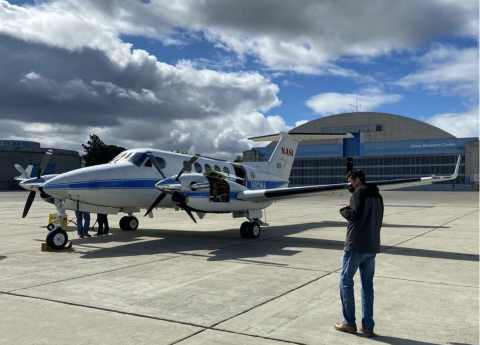
The first of three aircraft participating in the S-MODE campaign has arrived at Moffett Field in California. The NASA King Air B200 aircraft, carrying two science instruments – DopplerScatt and MOSES – landed on October 18th and is preparing for its first flight early in the morning on October 19th. The weather conditions have been changing and incoming storms in northern California are throwing a wrench into our planning for the airborne part of the campaign.




